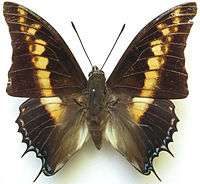Charaxes castor
Charaxes castor, the giant emperor or giant charaxes, is a butterfly of the family Nymphalidae. It is found throughout the Afrotropical realm below the Sahel.[2]
| Giant emperor | |
|---|---|
 | |
| Male | |
| Scientific classification | |
| Kingdom: | Animalia |
| Phylum: | Arthropoda |
| Class: | Insecta |
| Order: | Lepidoptera |
| Family: | Nymphalidae |
| Genus: | Charaxes |
| Species: | C. castor |
| Binomial name | |
| Charaxes castor | |
| Synonyms | |
| |
The wingspan is 75–85 mm in males and 85–105 mm in females. The flight period is year-round but more common in late summer to autumn.[3]
Description



A full description is given by Walter Rothschild and Karl Jordan, 1900 Novitates Zoologicae Volume 7:287-524. page 436 et seq. (for terms see Novitates Zoologicae Volume 5:545-601 )
Life history
Larvae feed on Bridelia micrantha, Afzelia quanzensis, Tragia spp., Gymnosporia spp., Maytenus senegalensis, Schotia brachypetala, Bridelia micrantha and Cassia fistula.[2][3]
Subspecies
Listed alphabetically.[2]
- C. c. arthuri van Someren, 1971 (Pemba island)
- C. c. castor (Cramer, [1775]) (throughout African range)
- C. c. comoranus Rothschild, 1903 (Comoros)
- C. c. flavifasciatus Butler, 1895 (eastern Kenya, northern and eastern Tanzania, Malawi, Mozambique, eastern Zimbabwe, South Africa, Swaziland)
Taxonomy
The members of the Charaxes jasius group are:
- Charaxes jasius
- Charaxes pelias – smaller than jasius
- Charaxes hansali
- Charaxes castor
- Charaxes brutus – dark with white bands
- Charaxes andara – Madagascar
- Charaxes ansorgei
- Charaxes phoebus
- Charaxes pollux
- Charaxes druceanus
- Charaxes phraortes – Madagascar, close to next
- Charaxes andranodorus – close to last
- Charaxes eudoxus
- Charaxes richelmanni
gollark: Just use machine learning™ to automatically do it.
gollark: Enzymes like specific temperatures for ??? chemistry reasons.
gollark: I mean, every other metabolic process runs at 37 degrees C fine.
gollark: I'm sure some other animals make it work.
gollark: It should simply be better designed.
References
- Afrotropical Butterflies: File H - Charaxinae - Tribe Charaxini
- "Charaxes Ochsenheimer, 1816" at Markku Savela's Lepidoptera and Some Other Life Forms
- Woodhall, Steve (2005). Field Guide to Butterflies of South Africa. Cape Town, South Africa: Struik. ISBN 978-1-86872-724-7.
External links
- Charaxes castor castor images at Consortium for the Barcode of Life
- Charaxes castor comoranus images at BOLD
- Charaxes castor flavifasciatus images at BOLD
- Images of C. castor castor Royal Museum for Central Africa (Albertine Rift Project)
- African Butterfly Database Range map via search
This article is issued from Wikipedia. The text is licensed under Creative Commons - Attribution - Sharealike. Additional terms may apply for the media files.